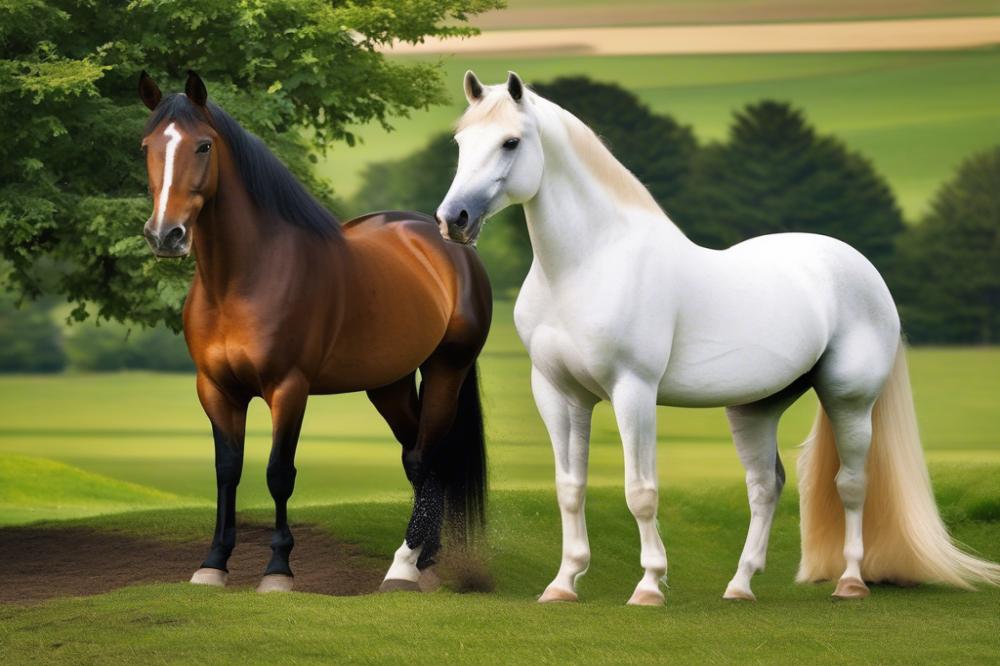The Art of Selecting the Perfect Breeding Pair
breeding horses is an exciting venture, but it requires careful thought. Selecting the right pair is crucial to the success of any breeding program. A good breeding pair can lead to offspring that excel in performance and temperament. When choosing horses to breed, understanding the significance of this decision is vital. It goes beyond the immediate goal of producing a foal; it’s about building a lineage with desired traits.
Several factors come into play during the selection process. One must consider the physical attributes and performance records of each horse. Health history and temperament also play an important role. Assessing these elements helps to predict the future of potential offspring. It’s not just about finding two strong horses; it’s about finding two that complement each other in several ways. genetic compatibility is essential for producing healthy foals.
Setting the stage for successful breeding requires knowledge and patience. Every breeding decision should reflect long-term goals. Each pairing should be examined in light of traits you wish to enhance. By thinking critically about each choice, breeders can build a stronger legacy in the equine world. In summary, breeding pair selection is an art. It combines science, intuition, and a deep understanding of horses.
breeding goals

Defining your breeding objectives is a critical step in the process of creating a successful breeding program. Objectives help clarify what you want to achieve through breeding activities. Consider what qualities are most important to you. This clarity will guide your decisions.
Types of Goals: Performance, Conformation, Temperament
There are several categories to think about when setting your goals. Performance relates to how well the animal can compete or work in a specific discipline. Conformation refers to the physical traits of the animal, such as structure and appearance. Temperament is about the animal’s behavior and personality. Each of these areas has its own importance based on your vision for the breeding pair.
Aligning breeding goals with Desired Traits
After identifying your goals, it is crucial to align those with the traits you want to emphasize in your breeding pair. Focus on the attributes that will help meet your objectives. For instance, if your aim is to produce show dogs, prioritize conformation traits. If performance is your focus, select animals known for their competitive abilities. Make sure to consider temperament too; an animal with a suitable nature will benefit any breeding program.
In every step, communication with other breeders can provide valuable insights. Seeking advice and exchanging experiences will sharpen your understanding of what traits to target. Learning from others can help you avoid common pitfalls and arm you with knowledge. Breeding is not just about choosing the right pair; it involves thoughtful consideration and careful planning. Address each aspect steadily for the best outcomes.
Phenotype and Genotype

Understanding phenotype and Its Significance
Phenotype describes the observable traits of an organism. These traits include physical appearance, behavior, and biochemical properties. Climate, diet, and environment can all influence phenotype. When selecting a breeding pair, you must consider these traits carefully. For example, size and coat color are vital for many breeding goals. The appearance of the animals can affect their marketability as well. Breeders often look for specific characteristics that will attract buyers or meet needs in the industry.
Role of Genotype in breeding pair selection
Genotype, on the other hand, refers to the genetic makeup of an organism. It holds the information that determines potential traits. While phenotype is what can be seen, genotype influences whether certain traits will be passed to future generations. Knowledge about the genes involved is crucial. Selecting a breeding pair with favorable genotypes can lead to desirable outcomes. Certain genetic combinations can improve health, fertility, or growth rates in offspring too. Understanding the genetic background of animals helps in making informed choices.
Balancing Phenotype and Genotype for Optimal Results
Finding the right balance between phenotype and genotype is essential. Without proper consideration of both aspects, you might achieve less than optimal results. Attractive physical traits alone may not guarantee the health or viability of the offspring. Conversely, a breeding pair with excellent genetic potential may not look ideal. Carefully planning breeding strategies requires thoughtfulness. Combining desirable physical traits with a strong genetic foundation can lead to excellent results. Breeders must continually evaluate both aspects for ongoing success. This dual focus will ultimately lead to improvements in the overall quality of the breed.
Health Screening

Health screenings play a critical role in breeding horses. They help to identify potential genetic issues before they can affect the foals. A strong emphasis on health can prevent many problems down the line.
Common health problems in horses include navicular disease, laminitis, and certain genetic disorders like hyperkalemic periodic paralysis (HYPP). Many factors contribute to these issues. Age, lineage, and environmental conditions all play a part in a horse’s overall health.
Recommended tests vary based on the breed and goals of the breeding program. A thorough veterinary examination is always a great start. Blood tests can check for genetic disorders and infectious diseases, which may lead to complications during pregnancy or affect the foal’s health later.
Radiographs are beneficial for assessing joint health, especially in younger horses. Important conditions, such as arthritis or musculoskeletal problems, may be detected. These results can guide breeding decisions to avoid passing on heritable issues.
Regular screenings focus not only on identifying existing conditions but also on monitoring overall well-being. Important vaccinations should be current. Routine dental check-ups are equally necessary to ensure good health.
Working closely with a veterinarian ensures every horse is given the best chance for a functional breeding career. A well-planned health screening program is essential in producing healthy future generations. Investing time and resources in this aspect increases success and contributes to the integrity of the breed.
Pedigree Analysis
Understanding pedigree is crucial in making smart breeding decisions. A solid pedigree reveals ancestral backgrounds. It provides insights into the genetics of a potential breeding pair. Responsible breeders utilize this information to identify strengths and weaknesses in bloodlines.
Importance of Pedigree in Breeding Decision
Each lineage tells a story about health and performance. Knowing the lineage helps prevent the passing of genetic disorders. A thorough pedigree analysis also aids in determining the potential of offspring. By evaluating traits from both parents, owners can predict what qualities may appear in the next generation. This foresight is integral in any breeding strategy.
Tools for Analyzing Bloodlines
Many tools are available for analyzing bloodlines today. Online databases can track lineage and health records effectively. Some breeders use specialized software that creates detailed family trees. Using these resources, one can trace back several generations. Information about titles, performance records, and any known health issues provides valuable context. Accurate tools lead to informed choices when selecting breeding partners.
Identifying Traits Through Pedigree Analysis
Traits pass down through families, often reflecting previous generations. Certain characteristics, such as size, coat color, and temperament, are often inherited. Analyzing pedigree allows breeders to spot these traits quickly. Breeders should look for consistent patterns in relatives. This examination can aid in anticipating what traits may emerge in offspring. Additionally, being mindful of genetic diversity is important, as it can minimize risks of inbreeding.
Line Breeding and Diversity
Exploring the Concept of Line Breeding
Line breeding is a specific breeding technique. It focuses on mating animals that share a common ancestor. This method aims to reinforce desirable traits in offspring. Breeders often appreciate line breeding for its simplicity. By selecting animals with shared lineage, they hope to keep traits consistent. However, this technique requires careful planning and knowledge of genetics.
Benefits and Risks of Line Breeding
One of the main benefits of line breeding is the concentration of desired characteristics. Breeders can accentuate traits like coat color or size. This focus can yield predictably behaving animals. Nonetheless, risks accompany this practice. Inbreeding depression can occur if related animals are bred too closely. Genetic disorders might surface in a breeding pair. Managing these risks is vital for maintaining a healthy lineage.
Importance of Genetic Diversity in Breeding
Genetic diversity plays an essential role in breeding. More variety increases the chances of healthy offspring. It helps prevent inherited diseases that might result from limited gene pools. Breeding programs should incorporate diverse bloodlines when possible. A varied genetic background allows for adaptability in changing environments. Striking a balance between line breeding and diversity is crucial. This combination can produce robust and well-adjusted animals.
Reproductive Success Factors
Factors Influencing Reproductive Success
Choosing the right breeding pair is crucial. genetic compatibility plays a significant role. Both mares and stallions must possess desirable traits. Health issues can hinder fertility. A solid veterinary check-up is essential. Age can also affect breeding efficiency. Older animals may have reduced viability. It is wise to consider physical soundness as well. The overall fitness of each animal greatly impacts reproductive outcomes. Furthermore, stress levels can influence success rates. Animals in a calm environment tend to reproduce more successfully.
Nutrition and Management for Breeding Mares and Stallions
Proper nutrition is fundamental for breeding horses. Balanced diets provide essential nutrients. Vitamins and minerals support reproductive health. Mares require extra protein during specific times. Stallions too need proper care leading up to the breeding season. Regular veterinary care helps in maintaining good health. Management practices include appropriate housing and exercise regimens. Healthy living conditions foster a better breeding environment. Attention to both the mare’s and stallion’s needs is vital. A well-managed breeding program can improve success rates significantly.
Importance of Timing and Environment in Breeding
Timing is a key factor in breeding. Estrus cycles determine the best mating times. Understanding the cycle of the mare is essential. Synchronizing the stallion’s availability with this cycle improves chances of successful breeding. Moreover, the environment can impact reproductive success. Seasons influence hormone levels and can affect fertility. A stable and controlled environment helps reduce stress. Factors like temperature and humidity should be monitored. These elements culminate in creating the best possible conditions for successful breeding outcomes.
Bringing It All Together
Careful selection of breeding pairs holds great significance in achieving desired outcomes. The process requires consideration of many factors, including genetics, temperament, and overall health. Selecting the right pair can lead to offspring that not only meet breeding goals but also contribute positively to the breed as a whole.
Successful breeding involves more than just finding compatible animals. It requires knowledge about phenotype and how different traits can combine. Each choice creates possibilities for the future, which is both exciting and daunting. Understanding the unique attributes of each potential mate can help steer the direction of the lineage.
Many breeders find that applying the principles discussed brings rewarding results. Careful planning leads to healthy, strong, and well-adjusted offspring. A thoughtful approach can produce generations that excel in their intended roles. It is essential to remember that this journey takes time and patience, but the rewards can be profound.
As you move forward, keep the concepts presented in mind. Strive to balance the various traits that matter most to you. Consider what best supports your breeding goals, and apply these ideas with confidence. Ultimately, a diligent approach to mating choices will yield the best results for your breeding program.



